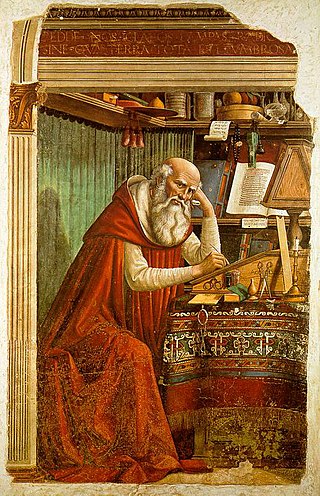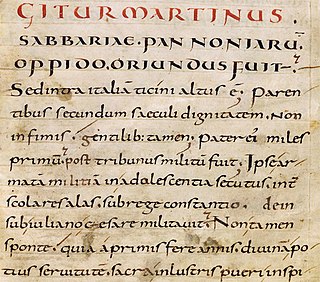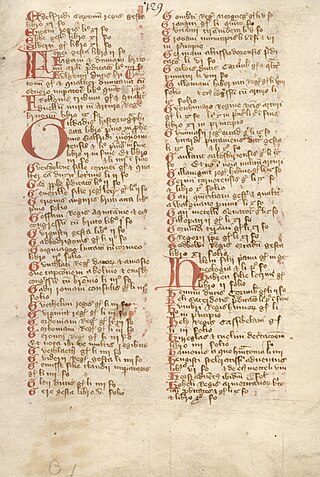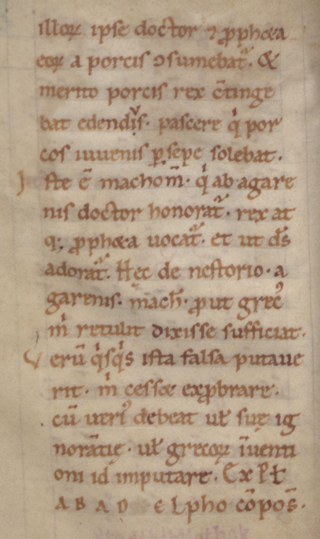
A number of biographies of Muhammad were written in Latin during the 9th to 13th centuries.

A number of biographies of Muhammad were written in Latin during the 9th to 13th centuries.
The earliest Latin biographies originated in Spain before the mid-9th century. They had a limited circulation and influence. [1] All other Latin biographies are ultimately based on the tradition of the Chronographia of Theophanes the Confessor (d. 818), translated into Latin in the 9th century by Anastasius Bibliothecarius, which contained a chapter on the life of Muhammad. [2]
While Latin biographies of Muhammad in the 11th to 12th century are still in the genre of anti-hagiography, depicting Muhammad as an heresiarch, the tradition develops into the genre of picaresque novel, with Muhammad in the role of the trickster figure, in the 13th century.
The Vita Mahumeti by Embrico of Mainz is an early example of the genre. The text, in rhyming leonine hexameters, was modelled on the verse hagiography of contemporaries such as Hildebert of Le Mans. It was most likely written between 1072 and 1090. It is in the tradition of the Chronographia of Theophanes, including the account of Muhammad's epilepsy and his body being eaten by pigs after his death. [3]
Twelfth-century versions include Otia Machometi by Walter of Compiègne (c. 1155) and Vita Machometi by Adelphus. [4] Thirteenth-century works of the romance type, written in Old French, include the Romance of Muhammad (1258), based on the Otia.
Biographies of Muhammad are also included in:

The Liber Pontificalis is a book of biographies of popes from Saint Peter until the 15th century. The original publication of the Liber Pontificalis stopped with Pope Adrian II (867–872) or Pope Stephen V (885–891), but it was later supplemented in a different style until Pope Eugene IV (1431–1447) and then Pope Pius II (1458–1464). Although quoted virtually uncritically from the 8th to 18th centuries, the Liber Pontificalis has undergone intense modern scholarly scrutiny. The work of the French priest Louis Duchesne, and of others has highlighted some of the underlying redactional motivations of different sections, though such interests are so disparate and varied as to render improbable one popularizer's claim that it is an "unofficial instrument of pontifical propaganda."

Artemius Anastasius, known as Anastasius II, was the Byzantine emperor from 713 to 715. His reign was marked by significant religious and political decisions aimed at stabilizing the Empire. One of his notable actions was reversing the previous appointment of a Monothelete patriarch of Constantinople, instead reinstating Orthodoxy by appointing Germanus I to the position. This move was made in an effort to gain the favor of Pope Constantine.

A hagiography is a biography of a saint or an ecclesiastical leader, as well as, by extension, an adulatory and idealized biography of a preacher, priest, founder, saint, monk, nun or icon in any of the world's religions. Early Christian hagiographies might consist of a biography or vita, a description of the saint's deeds or miracles, an account of the saint's martyrdom, or be a combination of these.
Theophanes the Confessor was a member of the Byzantine aristocracy who became a monk and chronicler. He served in the court of Emperor Leo IV the Khazar before taking up the religious life. Theophanes attended the Second Council of Nicaea in 787 and resisted the iconoclasm of Leo V the Armenian, for which he was imprisoned. He died shortly after his release.
George Syncellus was a Byzantine chronicler and ecclesiastical official. He had lived many years in Palestine as a monk, before coming to Constantinople, where he was appointed synkellos to Tarasius, patriarch of Constantinople. He later retired to a monastery to write what was intended to be his great work, a chronicle of world history, Ekloge chronographias, or Extract of Chronography. According to Anastasius Bibliothecarius, George "struggled valiantly against heresy [i.e. Iconoclasm] and received many punishments from the rulers who raged against the rites of the Church", although the accuracy of the claim is suspect.

The Battle of Pliska or Battle of Vărbitsa Pass was a series of battles between troops, gathered from all parts of the Byzantine Empire, led by the Emperor Nicephorus I, and the First Bulgarian Empire, governed by Khan Krum. The Byzantines plundered and burned the Bulgar capital Pliska which gave time for the Bulgarians to block passes in the Balkan Mountains that served as exits out of Bulgaria. The final battle took place on 26 July 811, in some of the passes in the eastern part of the Balkans, most probably the Vărbitsa Pass. There, the Bulgarians used the tactics of ambush and surprise night attacks to effectively trap and immobilize the Byzantine army, thus annihilating almost the whole army, including the Emperor. After the battle, Krum encased the skull of Nicephorus in silver, and used it as a cup for drinking. This is one of the most documented instances of the custom of the skull cup.
Anastasius Bibliothecarius was the librarian (bibliothecarius) and chief archivist of the Church of Rome and also briefly a claimant to the Papacy.

Saint Disibod (619–c.700) was an Irish monk and hermit, first mentioned in a martyrologium by Hrabanus Maurus. Hildegard of Bingen around 1170 composed a Vita of Saint Disibod He is commemorated on 8 September.
Embrico of Mainz is the author of the Vita Mahumeti, a Latin biography of Muhammad. The text is in rhyming leonine hexameters, extending to 1,148 lines. It was modelled on the verse hagiography of contemporaries such as Hildebert of Le Mans. It was most likely written between 1072 and 1090. The author of the Vita has been identified with the future provost of Mainz Cathedral, Embricho II.

Johannes Hymonides, known as John the Deacon of Rome, was a deacon of the Roman Church. He wrote a biography of Pope Gregory the Great. He was one of the most culturally significant figures at the papal Curia in the second half of the ninth century.
Walter of Compiègne was a French poet who lived in the middle of the 12th century and was a monk at Saint Martin's at Tours. He composed a Latin biography of Muhammad in elegiac couplets.
Chronographia, meaning "description of time", and its English equivalents, Chronograph and Chronography, may refer to:
Nonnosus was an ambassador sent by the Byzantine emperor Justinian I to the ruler of Kinda in central Arabia and then to Aksumites and Himyarites in the year 530 CE. He wrote an account of that visit, now lost, that was read and summarized by Byzantine patriarch Photius in Codex 3 of his Bibliotheca. According to Photius, the report emphasized the courage of Nonnosus in hazardous situations and contained information on the religion and language of the Arabs. Nonnosus entered Ethiopia through the Red Sea port city of Adulis and journeyed overland to Axum. He described Aksum as a "very large city" and the capital of Aethiopia. He described seeing a herd of 5000 elephants in the vicinity of Aua, between Adulis and Axum. He also mentions meeting pygmies on the islands of Farasan. Nonnosus' father Abraham had been an ambassador to the Arabs, and his uncle, also named Nonnosus, had been sent on an embassy by the emperor Anastasius I.

Bronwen Neil FAHA is an Australian academic. She is a Professor of Ancient History at Macquarie University. She is an expert on Byzantine Greek and medieval literature, early Christianity, and ancient letter collections in Greek and Latin.

The Courtenay Compendium is a medieval English manuscript containing a miscellany of historical texts. It contains three blocks of texts. The first concerns British and English history. The second has an oriental focus and contains accounts of Europeans in China, the Crusades, Islam and the rise of the Mongols. The third contains prophecies.

The Liber Nycholay is a Latin biography of Muhammad. It is an anonymous text, written in Italy in the later 13th century. Of no value as a historical source on Muhammad, it is a melding of various western Christian traditions concerning the origins of Islam written in such a way as to highlight the similarities between Islam and Catholic Christianity while satirizing the papal court.

The Book of Muḥammad's Ladder is a first-person account of the Islamic prophet Muḥammad's night journey (isrāʾ) and ascent to heaven (miʿrāj), translated into Latin and Old French from traditional Arabic materials. Although presented as Muḥammad's words and purportedly recorded by Muḥammad's cousin Ibn ʿAbbās, the work is in fact spurious and dates to the 13th century.

The Vita Machometi is a Latin biography of Muḥammad written by a certain Adelphus in the early to mid-12th century. Nothing is known of the author but what he reveals about himself in the Vita. This includes that he had heard the Muslim call to prayer and had conversed with a Greek about Islam while staying in Antioch on a return trip from Jerusalem. Taken together, these facts suggest that he may have been a participant in the First Crusade. He seems to have had a biblical and classical education. He may have been a Benedictine abbot.
Where Wicked Muhammad Came From is an anonymous Latin biography of Muhammad from the late 13th century. Although it contains some authentic Islamic elements, it consists mostly of legendary material or reworkings intended to ridicule and denounce Islam and its founder.
Vita Mahometi or Vita Machometi may refer to: